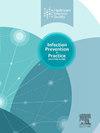Sodium dichloroisocyanurate: a promising candidate for the disinfection of resilient drain biofilm
IF 1.9
Q3 INFECTIOUS DISEASES
引用次数: 0
Abstract
Background
Biofilms are complex multicellular communities of microorganisms embedded within a protective matrix which confers resistance to various antimicrobials, including biocides. Biofilms can cause a range of human diseases and are responsible for 1.7 million hospital-acquired infections in the US annually, providing an economic burden of $11.5 billion in treatment costs. Biofilm contained within drain and plumbing systems may contain pathogenic viruses and bacteria which pose a significant risk to patient safety within healthcare environments.
Aim
The aim of this study was to determine if three hospital-grade disinfectants (sodium dichloroisocyanurate, peracetic acid and sodium hypochlorite) were capable of killing microorganisms within biofilm, and thus, determining their potential as candidates for drain biofilm disinfection.
Methods
Pseudomonas aeruginosa biofilms were cultivated using the CDC biofilm reactor, a standardised method for determining disinfectant efficacy against biofilm within the United States of America. Each disinfectant was tested using a one-minute contact time, using the highest concentration available on the product label.
Findings
The sodium dichloroisocyanurate product was successful in killing biofilm microorganisms, resulting in a log reduction of ≥ 8.70. Peracetic acid reduced biofilm by 3.82 log10 units, followed by sodium hypochlorite, which produced a reduction of 3.78 log10 units.
Conclusions
The use of a highly effective disinfectant with proven biofilm efficacy can help ensure patient safety and reduce infection levels. Drains and plumbing systems provide a reservoir for potential pathogens and biofilm; thus, drain disinfection is critical in reducing the instance of hospital-acquired infections. Sodium dichloroisocyanurate may provide a reliable solution for drain applications and subsequently, patient wellbeing and safety.
二氯异氰尿酸钠:弹性排水生物膜消毒的有前途的候选物
生物膜是嵌入在保护性基质内的复杂的多细胞微生物群落,可对包括杀菌剂在内的各种抗菌剂产生耐药性。生物膜可引起一系列人类疾病,每年在美国造成170万例医院获得性感染,造成115亿美元的治疗费用经济负担。排水和管道系统内的生物膜可能含有致病性病毒和细菌,这对医疗保健环境中的患者安全构成重大风险。目的本研究的目的是确定三种医院级消毒剂(二氯异氰尿酸钠、过氧乙酸和次氯酸钠)是否能够杀死生物膜内的微生物,从而确定它们作为排水生物膜消毒候选者的潜力。方法采用CDC生物膜反应器培养铜绿假单胞菌生物膜,CDC生物膜反应器是美国生物膜消毒效果测定的标准方法。每种消毒剂的接触时间为1分钟,使用产品标签上的最高浓度进行测试。结果:二氯异氰尿酸钠产品能成功杀灭生物膜微生物,对数降低≥8.70。过氧乙酸减少了3.82 log10单位的生物膜,次氯酸钠次氯酸钠减少了3.78 log10单位。结论使用经证实具有生物膜功效的高效消毒剂可确保患者安全,降低感染水平。排水管和管道系统为潜在的病原体和生物膜提供了一个储存库;因此,下水道消毒对于减少医院获得性感染至关重要。二氯异氰尿酸钠可以为排水应用提供可靠的解决方案,并随后,病人的健康和安全。
本文章由计算机程序翻译,如有差异,请以英文原文为准。
求助全文
约1分钟内获得全文
求助全文
来源期刊

Infection Prevention in Practice
Medicine-Public Health, Environmental and Occupational Health
CiteScore
4.80
自引率
0.00%
发文量
58
审稿时长
61 days
 求助内容:
求助内容: 应助结果提醒方式:
应助结果提醒方式:


